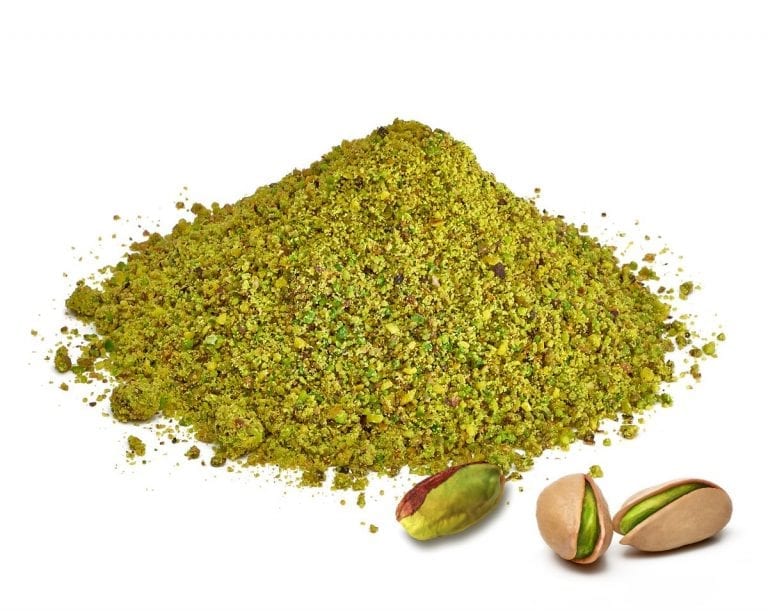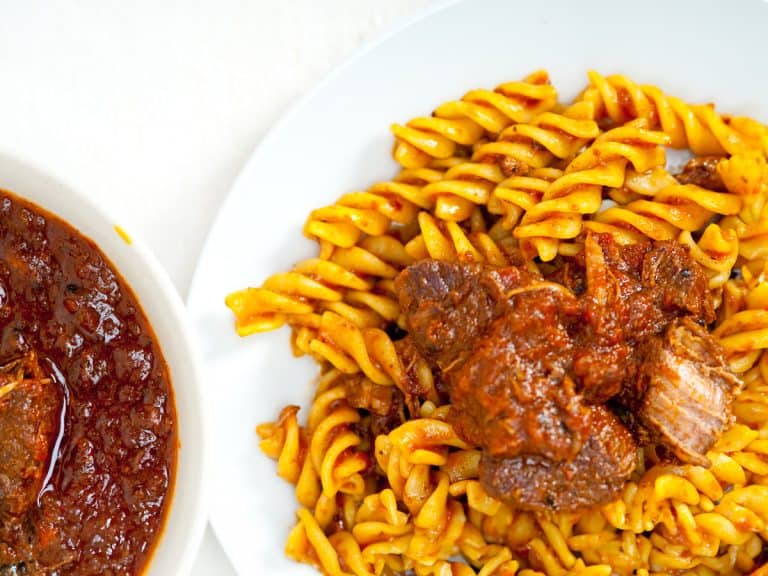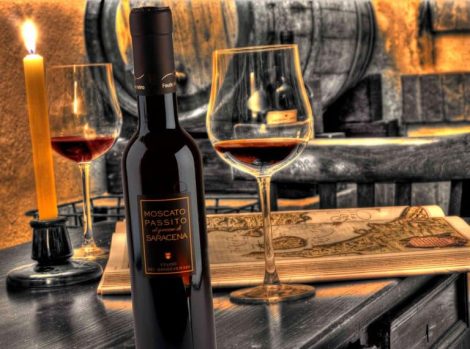Pellegrino Artusi used it in the preparation of a particular gelato with a pastel green hue, without imagining that after a few years the large confectionery companies would replace it with food colourings, much less expensive than dried fruit. Its natural flavour, however, is unique and inimitable: nothing to do with the synthetic aromas added to large-scale retail snacks. If you've ever used pistachio flour in your cooking, you will already know what we are talking about: this product stands out for its intense, slightly sweet and slightly bitter aftertaste, and for the toasted notes reminiscent of lightly roasted seeds on a live flame. Nothing cloying, therefore. This is demonstrated by the fact that it often ends up also in savoury dishes, such as grilled tuna or trofie pasta with green sauce. If your mouth is already watering, know that we have selected for you the best recipes using pistachio flour. But first, here are all the instructions for choosing quality products.
Pistachio flour characteristics
By definition pistachios have a pale green colour or, at most, chlorophyll green. If the flour obtained from their grinding appears too dark or bright it means that there's something wrong. Fortunately, correcting the hue of the raw product is an increasingly less common trick, but often gelato, spreads and sweets that contain it are "strengthened" with food colourings of dubious origin. Better, therefore, to check the label carefully and choose foods made with few quality raw materials, being wary of long lists full of artificial aromas and additives. Pistachio flour is prepared by shredding the previously shelled and peeled nut in order to obtain a fairly fine powder which, however, has a more irregular grain than wheat or legume flours; the texture is also very different (to the touch it leaves a "greasy" feeling on fingers, like almond flour, due to the oils that are naturally contained in the nuts), while the intense aroma makes it an ideal ingredient for flavouring puddings, biscuits and sponge cakes.
Pistachio flour: how to make it and where to find it
Preparing pistachio flour at home is very simple: just blend the nuts in a mixer. However, we advise you to carry out the procedure rather quickly and in short bursts, in order to avoid overheating of the blades which oxidize the nuts, and to add 2 teaspoons of cornstarch every 100 grams of flour, to make it more homogeneous. Alternatively, you can buy it at specialised shops or websites. The best solution is to contact certified companies, always asking for precise information about the origin and type of nuts used in the recipe. Try to avoid producers who exploit the myth of the Bronte Pistachio for commercial purposes, making their emerald green processed products a source of pride: of course, each variety of pistachio has its own characteristics, but psychedelic nuances are not admitted.
Pistachio flour properties
Not only tasty, fragrant and versatile, but also nutritious: pistachio flour preserves all the beneficial substances of dried fruit (which in this case, unlike chestnut flour, is not subjected to too high temperatures before refining) and can be safely consumed by coeliacs and people with wheat protein intolerance due to the absence of gluten. The content of "good fats" (52 g on the total weight), folate such as vitamin B9 and fibers that regulate intestinal transit and promote the sense of satiety is remarkable. Of course, the lipid component greatly affects the nutritional values: we are talking about a product with a high energy profile, with more than 570 calories per 100 g. It's also true, however, that the high level of protein (21 g, a little less than chickpea flour) and the scarcity of carbohydrates (just 6.5 g) allow it to be mixed with other flours––such as rice, farro (spelt) or simply soft wheat––to prepare complete and balanced dishes, with health benefits. Among the noteworthy properties it's worth highlighting the preventive effect against heart disease, lowered blood sugar and "bad" cholesterol (LDL) levels in the blood and the hydration of skin tissue. Thanks to the fair amount of copper present in pistachios, the flour obtained from it helps to facilitate the absorption of iron from other food sources.
Recipes with pistachio flour
Whether for pastas or for main courses, pistachio flour is a phenomenal help in the kitchen, thanks to that aromatic, fatty component with an unmistakable texture that goes so well with different combinations. One of the most popular is with fish, starting with red prawns, even raw, chopped made into tartare for an appetizer or to complete a delicious plate of spaghetti. Or, still in the dry pasta realm, prepare durum wheat fusilli with baby octopus and pistachio pesto, adding the chopped nuts in the form of flour in the blender jug to save time, or use it together with breadcrumbs and egg whites for breading tuna steaks: a great crust will form during cooking on a hot griddle. Do you fancy a sweet treat? Pistachio flour is the right ingredient to prepare delicious and eye-catching desserts in record time: try it as a replacement for almond flour in the Torta Caprese cake recipe, or making a creamy ricotta di bufala mousse with raspberry coulis and pistachio streusel by Andrea Golino: perfect to serve at the end of a meal to satisfy even the most demanding palates. Among the Sicilian recipes, the soft pistachio pastries deserve mention––cookies made with almond and pistachio flour, egg whites, honey, lemon zest and icing sugar. There's also the typical semifreddo made with crumbled nuts and pistachio cream and the cake with pistachio decorated with berries (here in Maurizio Santin's version). If, on the other hand, you love spreads, in this article you will find the procedure for making pistachio creams at home with the precious advice of the Pasticceria Corsino in Palazzolo Acreide. Other ideas? Use it to sweeten mascarpone and enrich your pistachio tiramisu, or replace it in small doses with flour in any muffin recipe.
Croccolosa al pistacchio recipe of Pasticceria Ernesto in Catania
The Urzì family of Pasticceria Ernesto (Due Torte for our Pastry Chef & Pastry Shop Guide of Italy) gives us the recipe for the legendary Croccolosa cake. Roll up your sleeves and… happy baking!
Ingredients (for 8 people)
For the pistachio biscuit:
7 eggs
230 g sugar
230 g pistachio flour
1 vanilla pod
70 g “00” type flour
50 g butter
6 egg whites
175 g di zucchero
For the brittle:
500 g pistachio praline
300 g crunchy sugar flakes ("paillette")
250 g pistachio spread
For the crème anglaise
250 g milk
250 g full fat cream
125 g sugar
6 egg yolks
For the pistachio Bavarois:
350 g full fat cream
200 g crème anglaise (made with above ingredients)
12 g isinglass
50 g pure pistachio paste
For the pistachio praline insert:
150 g pistachio paste
175 g pistachio praline
25 milk
2 g Maldon salt
For the pistachio icing:
½ l full fat cream
12 g isinglass
750 g white chocolate
300 g neutral gelatin
100 g pistachio spread
First, prepare the pistachio icing. Rehydrate the isinglass with 60g of water and add it to the cream previously brought to a boil in a saucepan. Stir vigorously, then add the white chocolate, neutral gelatin and pistachio paste to the mixture. Mix everything vigorously. Transfer the mixture to a bowl, cover it with cling film and allow it to cool to room temperature. Keep refrigerated and use after 24 hours
To make the pistachio biscuit, whip the whole eggs together with the vanilla bean seeds with electric beaters for about 20 minutes. Meanwhile, sift the 2 flours in a large bowl and melt the butter in a steel saucepan or in the microwave.
When the mass is whipped, add the flours and melted butter, mixing with a spoon from bottom to top. In a separate container, beat the egg whites with the sugar until stiff, then fold into the other ingredients and mix until a compact dough is obtained. Roll out the dough with a rolling pin 5 mm thin and bake it in a mold lined with parchment paper for about 10 minutes at 210°C.
At this point, make the crème anglaise by thickening all the ingredients listed in a saucepan, without ever reaching a boil (if you have a cooking thermometer, check that the temperature does not go beyond 82°C). Stir constantly to prevent the mixture from sticking to the bottom and continue until a creamy consistency is obtained.
To prepare the Bavarois, dissolve the isinglass in a little water over low heat. Whip the full fat cream and add it to the crème anglaise previously mixed with the pistachio and the isinglass dissolved in the liquid.
Finally, prepare the pistachio praline. After bringing the milk to a boil, add it to the pistachio cream and the pistachio praline, then emulsify everything together with the salt.
To compose the cake, use a circle-shaped mold with a diameter of 20 cm and cut out the biscuit of that size. Place the biscuit in a 20 cm cake pan and let it cool in the freezer for a few minutes. Cover the biscuit with brittle and put the mold in the freezer for 5 minutes, then spread it with half of the pistachio Bavarois cream and let it solidify again in the freezer for 5 minutes. Add all the pistachio praline and, finally, the second layer of Bavarois. Place in the freezer for at least two hours and, after this time, pour over the cake all the pistachio glaze.
Pasticceria Ernesto - v.le R. di Lauria, 91- 95127 Catania (CT) - 095491680
by Lucia Facchini


 Neapolitan or Bolognese? The (tomato-free) history of the two ragùs that divide Italy
Neapolitan or Bolognese? The (tomato-free) history of the two ragùs that divide Italy Dom Perignon for dogs and sleepless rock stars: the bizarre requests to the world’s best hotel manager
Dom Perignon for dogs and sleepless rock stars: the bizarre requests to the world’s best hotel manager The oil always moves north, reaching England. How the map of olive trees is changing due to climate change
The oil always moves north, reaching England. How the map of olive trees is changing due to climate change The Nobel Sandwich we tried at CERN, just steps from antimatter
The Nobel Sandwich we tried at CERN, just steps from antimatter The two young talents from Gattinara revolutionising Italian cuisine
The two young talents from Gattinara revolutionising Italian cuisine






